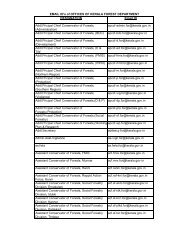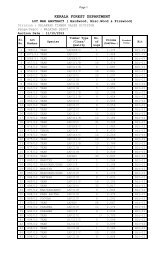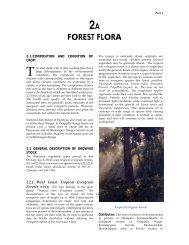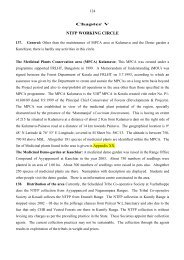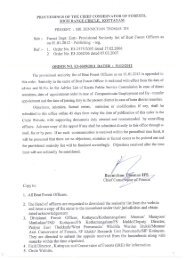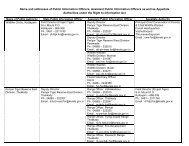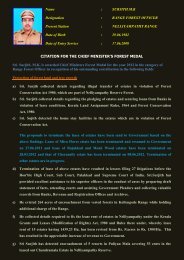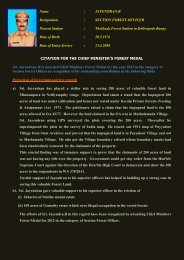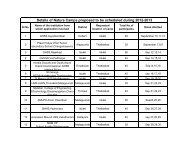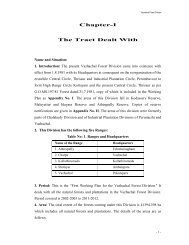Flora and Fauna
Flora and Fauna
Flora and Fauna
Create successful ePaper yourself
Turn your PDF publications into a flip-book with our unique Google optimized e-Paper software.
KONNI DIVISIONFLORAFOREST TYPESAs per revised classification of the forest types of India by M/S.Harry.G.Champion <strong>and</strong> H.C Seth, the main forest types of Konni Forest Division are:1. WEST COAST TROPICAL EVERGREEN FORESTS (1/AC4)2. WEST COAST SEMI- EVERGREEN FORESTS (2/AC2)3. SOUTHERN MOIST MIXED DECIDUOUS FORESTS (3B/C2)4. WET REED BRAKES (1B/E2)5. GRASSLANDS6. PLANTATIONS1. WEST COAST TROPICAL EVERGREEN FORESTS (1/AC4)GeneralThis type consists of dense forest of lofty evergreen trees of numerous species.The trees form a close canopy. Not more than 1% of the total number consists of the uppercanopy. Clear boles of more than 30m height are common. Some of the trees aredeciduous to some extent, but do not affect the evergreen nature of the forests as a whole.The canopy is dense. It has been observed that except the lofty trees, which project wellabove the general canopy, differentiation into different canopy layers does not exist.Epiphytes, ferns, mosses <strong>and</strong> orchids are numerous. Long cylindrical boles with thinsmooth bark are typical but plank buttresses are also frequently seen. The leaves are thick<strong>and</strong> glossy, only rarely pinnate or hairy <strong>and</strong> are very often white or pink when young.Climbers vary greatly, sometimes conspicuous but not so abundantly observed as in semievergreen<strong>and</strong> moist deciduous types. Ground vegetation may be absent in some cases,but stretches of Strobilanthus <strong>and</strong> ferns may occur. Grasses are generally absent.Canebrakes may be seen along the stream banks.This type of vegetation is seen on the lower hills <strong>and</strong> in a narrow strip of 5 to 10chains along the watercourses. Semi-evergreen <strong>and</strong> deciduous types are seen encroachinginto evergreens in many a place.Occurance of Evergreen ForestsRangeLocalityKonniNaduvathumoozhy 1. Kurichikanam (beyondKottampara inKokkathode Forest Station).2. Narakanaruvi Thode (Adjacent tothereed patch).Mannarappara 1. Chembalakar (Eastern mostportion).2.MuthenThode (Perillappara area)3. KaichiraExtent in Ha.(Approximate)Nil5007575050050
Total1825Top CanopyCommonly occurring tree species in the top canopy are: - Vateria indica, Hopeaparviflora, Dysoxylum malabaricum, Hardwickia pinnata, Calophyllum species, Canariumstrictum, Anacolosa densiflora, Artocarpus hirsuta, Eugenia species, Diospyrosmelanoxylon, Polyalthia fragrans, Persea macarantha, Lophopetalum wightianum etc.Lower canopyMyristica species, Terminalia bellerica, Vitex altissima, Hydnocarpus species,Cinnamomum species, Nephelium longanum, Alstonia scholaris, Canarium strictum,Evodia roxburghiana, Aporosa lindlyana etc.UndergrowthStrobilanthus, Glycosmis pentaphylla, Globba ophioglossa, Costus species,Curcuma species, Cardamomum etc. Ochl<strong>and</strong>ra travancorica is present in certain areasonly.ClimbersEntada species, Abrus precatorius, Calamus species, Piper longum, Smilaxspecies, Dioscorea species etc.Shrubs : - Leea indica, Chassalia curviflora, Thottea siliquosa, Memecylon sp.Climbers : - Smilax ceylanica, Toddalia asiatica, Raphidophora pertusa,Ancistrocladus heyneanus, Strychnos colubrina, Myxopyrum smilacifolium, Jasminum sp.2 WEST COAST SEMI-EVERGREEN FORESTS (2/AC2)GeneralThis type exists as intermediate areas between tropical evergreens <strong>and</strong> moistdeciduous forms. This type consists of both evergreen <strong>and</strong> deciduous species. The numberof species is high, but comparatively less than in true evergreen <strong>and</strong> many of the biggestevergreens are absent. Canopy is less dense than in case of true evergreens. Evergreenundergrowth is in abundance. Climbers tend to be very heavy. Epiphytes are morecommon which includes ferns <strong>and</strong> orchids.Occurance of Semievergreen ForestsRangeLocalityExtent in Ha.(Approximate)Konni Kakkara (Avoilikuzhy area) 500Naduvathumoozhy 1. Narakanaruvi Thode (Right side fevergreen patch).2. Kurichikkanam3. Choolaplavu300500200Mannarappara1. Thailampara – Kodamala Area2. Karadippara3. Idukkupara – Adabhukitti750250250
Total2750Top canopyArtocarpus hirsuta, Hopea parviflora, Adina cordifolia, Lagerstroemia lanceolata,Terminalia paniculata, T. tomentosa, Salmalia malabarica, Tetrameles nudiflora, Vitexaltissima, Holoptelia integrifolia, Vateria indica, Lophopetalum spp., Calophyllum elatum,Persea macarantha, Grewia tiliaefolia, Terminalia bellerica, Pterocarpus marsupium etc.Lower canopyPolyalthia fragrans, Canarium strictum, Cinnamomum zeylanicum, Aporosalindleyana, Mallotus philippinensis, Phyllanthus emblica, Bridelia retusa, Albizziaodorotissima etc.UndergrowthStrobilanthus species, Glycosmis pentaphylla, Clerodendron species, Ochl<strong>and</strong>ra<strong>and</strong> Curcuma etc.ClimbersCalamus species, Entada species, Phaseoloides species, Hemidesmus indicus,Ipomea species, Butea superba etc.Sample Vegitation FeaturePlace : - Kurichikkanam (Kottampara or Kurichi)Range : - NaduvathumoozhyTree Species: - Artocarpus hirsutus, Knema attenuata, Terminalia paniculata,Lagerstroemia microcarpa, Aporusa lindleyana, Syzygiumlaetum, Croton malabaricus, Ixora brachiata, Turpiniamalabarica, Mallotus philippensis, Sterculia guttata,Diospyros buxifolia, Cinnamomum sp., Litsea coriacea,Chionanthus mala-elengi.Shrubs : - Strobilanthes sp., Thottea siliquosa, Leea indica.Climbers: - Acacia caesia, Pothos sc<strong>and</strong>ens, Calycopteris floribunda,Ancistrocladus heyneanus, Smilax ceylanica, Jasminum sp.3. SOUTHERN MOIST MIXED DECIDUOUS FORESTS (3B/C2)GeneralClosed high forest, often 30M or more in height, with the dominant species beingmostly deciduous. Although intimate mixture of the species is the rule, a relatively smallnumber of species together form the greater part of the canopy. Some eminent evergreendominants are included but few. The evergreen habit is more developed in the lower storygiving the forests as a whole a more or less evergreen appearance most of the year. Canesare restricted to wet ground <strong>and</strong> epiphytes mostly to post climaxes in damp shady places,climbers being abundant <strong>and</strong> large. Annual fires have greatly influenced the undergrowthoften maintaining it as a sub climax. Spread of grasses due to the fires become heavy <strong>and</strong>advances especially where the canopy is open. Repeated fires <strong>and</strong> grazing are the mainreasons for the absence of small trees <strong>and</strong> saplings of large tree species.
The moist deciduous forest is mostly leafless in the dry season, mostly in March-April when the upper canopy is almost entirely leafless though there is often a goodcoverage of evergreens in the lower canopy. A good number of the deciduous trees comeinto new leaf mostly with inflorescence, fairly well in advance of the monsoons. Teak shedsleaves early in the cold weather in drier regions <strong>and</strong> is almost evergreen in wet regions.OccuranceMost of the forests of this Division come under this type of vegetation. Higherelevations of Konni <strong>and</strong> Achencoil reserves support only moist deciduous type of forests.The forests in the lower hills of other reserves have been converted into either Teakplantations or agricultural l<strong>and</strong>s <strong>and</strong> what is left on the higher elevations come under thistype.This type covers an area of 13975.9108 Ha.Top canopyTerminalia paniculata, T. tomentosa, T. bellerica, Pterocarpus marsupium,Albizzia species. Alstonia scholaris, Dillenia pentagyna, Lagerstroemia lanceolata, Brideliaretusa, Salmalia malabarica, Grewia tiliaefolia, Tectona gr<strong>and</strong>is, Xylia xylocarpa, etc.Lower canopyXylia xylocarpa, Careya arboria, Cassia fistula, Strichnos nux vomica, Phyllanthusemblica etc.UndergrowthClerodendrum viscosum, Helecteres isora, Eupatorium odorotum, Ochl<strong>and</strong>raspecies, Curcuma species, Sacharum spondaneum, Lantana camara, Glycosmispentaphylla, etc.ClimbersAcacia species, Zizyphus species, Bauhinia vahli, Hemidesmus indicus, Passifloraspecies, Asparagus racemosus, Calicopteris floribunda, Spatholobus roxburghii etc.Sample Vegitation FeaturePlace : - Pappini (Kokkathode)Range : - NaduvathumoozhyTree Species : - Xylia xylopara, Terminalia paniculata, Terminaliacrenulata, Mitragyna tubulosa, Lagerstroemiamicrocarpa, Tectona gr<strong>and</strong>is, Dillenia pentagyna,Anogeissus latifolia, Bridelia crenulata.Shrubs : - Helicteres isora, Chromolaena odorata.Climbers : - Calycopteris floribunda, Cyclea peltata, Hemidesmusindicus.Place : - Kambiyadichampara (Chembala)Range : - Mannarappara
Tree Species : - Dillenia pentagyna, Terminalia paniculata, Terminaliacrenulata, Phyllanthus emblica, Holarrhena pubescens,Anogeissus latifolia, Dalbergia lanceolaria, Miliusatomentosa, Tectona gr<strong>and</strong>is, Pterocarpus marsupiumBridelia crenulata, Stereospermum colais, Careyaarborea.Shrubs : - Chromolaena odorata.Climbers : - Spatholobus parviflorus.Place : - Pekuzhi (Chembala)Range : - MannarapparaTree Species : - Wrightia tinctoria, Mallotus philippensis, Aporusalindleyana, Schleichera oleosa, Dillenia pentagyna,Bombax ceiba, Terminalia paniculata, Grewia tiliifolia,Bridelia crenulata, Cassia fistula, Dalbergia latifolia.Shrubs : - Chromolaena odorata, Helectere isora.Climbers : - Calycopteris floribunda, Spatholobusparviflorus.Place : - KakkaraRange : - KonniTree Species : - Aporusa lindleyana, Pterospermum rubiginosum,Sterculia guttata, Actinodaphne malabarica, Perseamacrantha, Dalbergia latifolia, Stereospermum colais,Lagerstroemia microcarpa, Holarrhena pubescens,Terminalia paniculata, Dillenia pentagyna, Cassiafistula, Macarnga peltata, Mitragyna tubulosa, Oleadioica.Shrubs : - Helecteres isora, Chromolaena odoratea.Climbers : - Anamirta cocculus, Calycopterisfloribunda.Place: - Chavarp<strong>and</strong>iRange : - KonniTree Species : - Wrightia tinctoria, Stereospermum colais, Strychnosnux-vomica, Mallotus philippensis, Aporusa lindleyana,Shleichera oleosa, Macaranga peltata, Dilleniapntagyna, Bombax ceiba, Terminalia paniculata,Terminalia bellirica, Lagerstroemia microcarpa, Oleadioica, Grewia tiliifolia, Persea macarantha, Sterculiaguttata, Alangium salgifolium.Shrubs : - Chromolaena odorata, Helecteres isora, Clerodendrumviscosum.Climbers : - Calycopteris floribunda, Acacia caesia, Spatholobuspargbflorus.4. WET REED BRAKES (1B/E2)1 GeneralSpecies of Ochl<strong>and</strong>ra (reeds) frequently occur in damp sites in the evergreen <strong>and</strong>semi-evergreen forests. It may occur as pure patches along stream banks or scatteredclumps found where canopy is not dense. The most common species found is Ochl<strong>and</strong>ratravancorica (Kareetta) though Ochl<strong>and</strong>ra ebracteata (Vellaeetta) is rarely seen alongstream sides in moist deciduous forests.
NaduvathumoozhyMannarappara1. Appooppanthode2. Kurichikkanam3. Chettuthadom4. Padom5. Nellidappara6. Neeramakulam1. Chittar - Kodamala2. Mulamon3. Avanippara4. Kaichira5. Palakuzhi6. Chempanaruvi (in TeakPlantation)7. Valayam (1999 treatmentareaunder KFP)8. Kuttackal I (1999 treatmentareaunder KFP)9. Kuttackal II (1999 treatmentareaunder WGDP)10. Palakappara (2000treatmentarea under KFP)10025101025105010101010550505053Total 493HighMedium””Low”Medium”””Low”High”””SpeciesFive species of canes exist in Konni Division viz. (1) Calamus delessertianus(Ottamoodan Chooral), (2) Calamus hookerianus (Kakka Chooral), (3) Calamus twaitesii(V<strong>and</strong>i Chooral), (4) Calamus travancoricus (Arichooral), <strong>and</strong> (5) Calamus Vattayila.Bamboos2.1.7.1 Bamboos are seen as gregarious patches in the natural forests <strong>and</strong> the plantationsin varying intensities.Occurance of BamboosRangeKonniNaduvathumoozhyLocality1. Pulichimavu2. Kilikulam3. Varikanjili4. Perumala1. Pullumuruppu2. Ooppathumuruppu3. Pinangathode4. Nellikkappara5. Kunnathadom(Varakanaruvi)6. Kaduvappara7. Vatteera8. Kattathi9. MundomoozhyApproximateExtent (Ha.)2560404075505050505050303050IntensityHighMediumLow”High”””””””MediumLow
Mannarappara10.Attippara11.Kanjirappara12.Neeramakulam13.Kurichi14.Parakulam1. Paykuzhy2. Kodumon3. Vanakan4. Aringatti5. Korangadi6. Perillappara7. Malamon8. Idukkupara9. Chembala10.Kampiyadichanpara11.Palakkapara12.Kaikunnam13.PalakuzhyTOTAL505025155050150605050505050502515101450””””High”Medium”””””Low””””SpeciesThe species found in this Division is Bambusa bambos (Bamboosa arundinacea,Bamboosa spinosa , Bambos arundinacea , Arundo bambos) <strong>and</strong> Ochl<strong>and</strong>ra wightii (Erakalli).The latter is very rare in the semi-evergreens at higher elevations.Blackwood (Ebony)The blackwood (Diospyros ebenum) occurs in a scattened manner in Thailampara,Kurangadi <strong>and</strong> Kodamala areas of Mannarappara Range in an extent of about 200 Ha.Cycas CircinalisCycas occurs in a scattered manner in Udumpaoor (25 Ha.) <strong>and</strong> Mundomoozhy (50Ha.) in Konni Range, Mannarappara (50 Ha.), Nirathupara (25 Ha.), Vayakkara (25 Ha.)<strong>and</strong> Thalamanom in Naduvathumoozhy Range.FAUNAThe area with the different habitat types, the network of streams <strong>and</strong> rivers, <strong>and</strong> the variedelevations supports fauna rich in number <strong>and</strong> varieties.Mammals:Tiger (Panthera tigris), Leopard (Panthera pardus), Leopard cat (Felis chaus), Dhole(Cuon alpinus), Jackal (Canis aureus), Common mongoose (Herpestes edwardsi), Ruddymongoose (Herpestes smithi), Toddy cat (Paradoxurus hermaphroditus), Small Indian civet(Viverricula indica), Sloth bear (Melursus ursinus), Threestriped palm squirrel(Funambulus palmarus), Malabar squirrel (Ratufa indica), Common giant flying squirrel(Petaurista petaurista), Indian porcupine (Hystrix indica), Blacknapped hare (Lepusnigricollis nigricollis), Indian mol rat (B<strong>and</strong>icota bengalensis), B<strong>and</strong>icoot rat (B<strong>and</strong>icotaindica), Elephant (Elephas maximus), Gaur (Bos gaurus), Sambar (Cervus unicolor),Barking deer (Muntiacus muntjak), Mouse deer (Tragulus meminna), Indian pangolin(Manis crassicaudata), Wild boar (Sus scrofa), Bonnet macaque (Macaca radiata), Nilgiri
langur (Presbytis johmi), Slender loris (Loris tardigradus), Flying Fox (Pteropus giganteus),<strong>and</strong> Fulvous fruit bat (Rosettus leschenaulti).Birds:About 200 species of birds common to the lower elevation Western Ghat of Keralaare seen. Peacock <strong>and</strong> the Great pied Hornbill, though rare, are present.Reptiles:Monitor lizard (Varanus versicolor), Garden lizard (Calotes), Mabuia, Cobra (Najanaja), King cobra (Ophiophagns Hannah), Python (Python molurus), Vipers (Vipera ruselli),Krait (Bangarus caeruleus), Rat snake (Ptyas mucosus), Tree snake (Dendrophis), Watersnake (Enhydris enhydris), Turtles, etc.Amphibians:Rana sp., Rhacophorus sp., Hyla sp., Microhyla sp., Bufo sp., etc.Fishes:Common fresh water fishes such as Ophiocephalus, Saccobranchus, Clarius, Torkudri etc.The areas rich in Wild mammals are Chembalakkar, Vayak<strong>and</strong>om, Kurangadi, <strong>and</strong>Kodamala in Mannarappara Range; Parakkulam <strong>and</strong> Parayanthode inNaduvathumoozhy Range; <strong>and</strong> Udumbannoor, Madanthamon <strong>and</strong> Avolikuzhy inKonni Range. These areas are also indentified tiger territories due to the rich preybase. Sambar, Wild boar, barking deer <strong>and</strong> mouse deer form the major preybase fortiger.



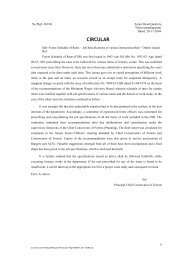
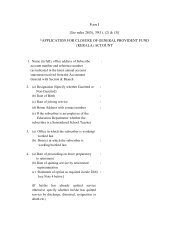
![[See rules 14 & 37(1)] FORM OF APPLICATION FOR TEMPORARY ...](https://img.yumpu.com/49611345/1/190x245/see-rules-14-371-form-of-application-for-temporary-.jpg?quality=85)
